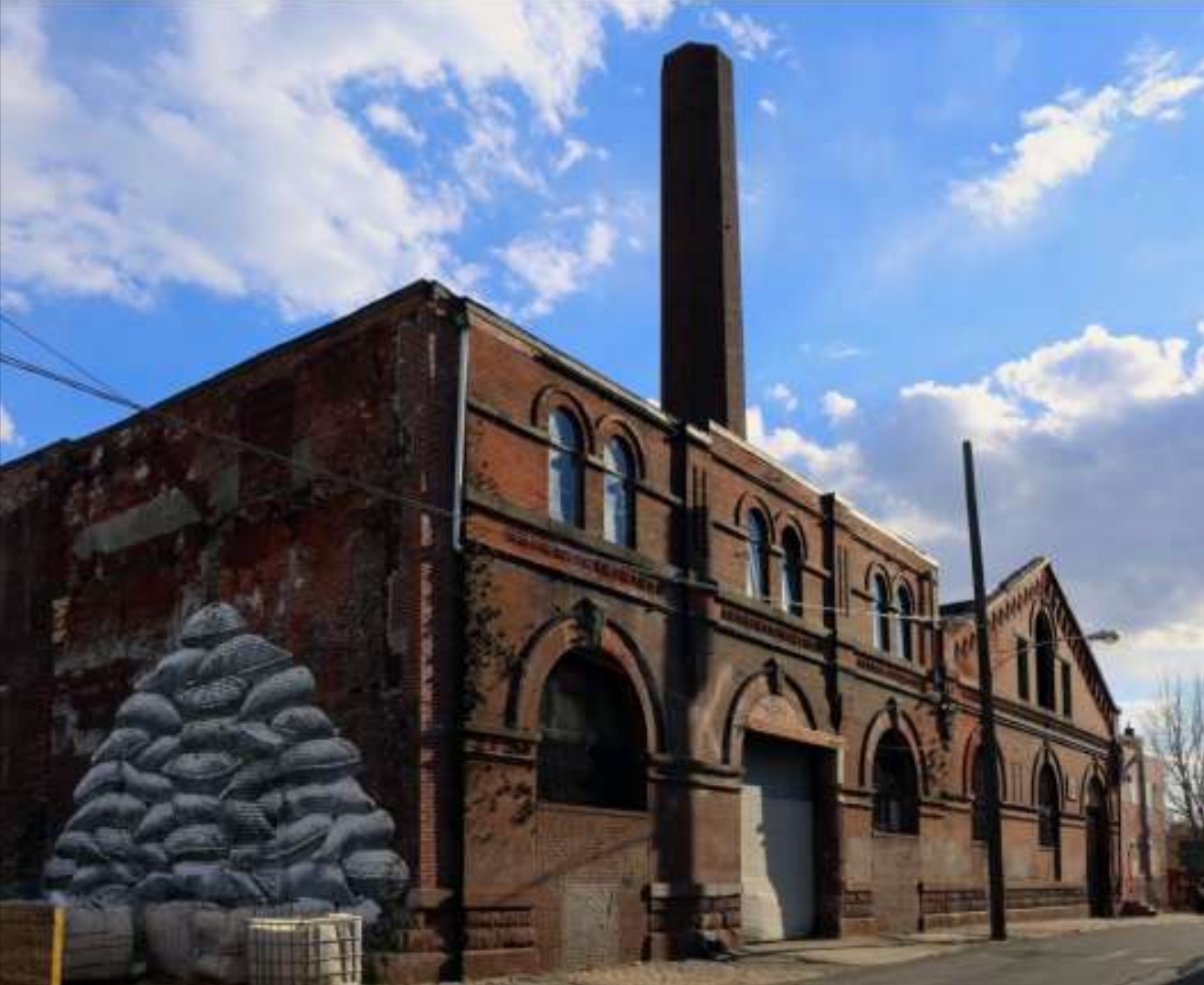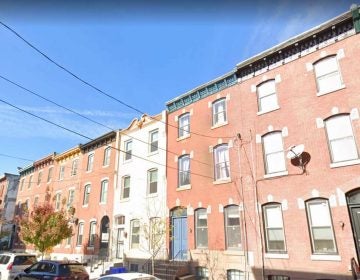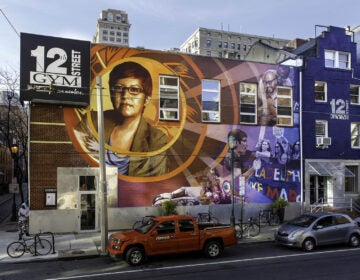Nine properties recommended for historic designation to finish 2016

After the fireworks around St. Laurentius that kicked off the December 14 meeting of the historical designation committee, there were another 12 properties on the agenda. Some proved just as contentious as the Fishtown case, although none were so well attended.
At the top of the meeting, 60 day continuances were issued for the Tabor Chapel at 1642 Fitzwater Street and for the interior designation of the Rohm & Haas building on Independence Mall. As a counterpoint to the almost two-hour meeting about St. Laurentius, the immediately subsequent consideration of the Pennsylvania Industrial Home for Blind Women at 3827-33 Powelton Avenue took place swiftly and without controversy. The committee recommended its addition to the local historic register, as it would for the rest of the properties on the agenda.
Christ Methodist Episcopal; Church/Mt. Pleasant Primitive Baptist Church: 435-41 N 38th Street
This 145-year-old Gothic-revival style church is the home of the Mount Pleasant Primitive Baptist Church, but was once the Christ Methodist Episcopal Church. It was also designed in part by George W. Hewitt and Frank Furness, a fact that the nomination makes much hay out of. But committee member Jeff Cohen, an architectural historian, of wasn’t convinced of the extent of Furness’ involvement. “Furness name gives more protection, but this may have been more Hewitt than Furness for all we know,” said Cohen. “But guess who gets the press.”
The committee than recommended adding the building to the register.
Former Weisbrod and Hess Brewery: 2117 E York Street
The nomination of the old Weisbrod and Hess Brewery in East Kensington is being contested by the owners, who are represented by veteran zoning lawyer Carl Primavera.
One of the owners, Anton Michels, is president of the German Society of Pennsylvania. He described himself as a preservation devotee, but disagreed that this building should be added to the register. Michaels said he simply didn’t believe Weisbrod and Hess Brewery to be as historically significant as the nomination contends.
“I think this paperwork for the historic commission was copy and pasted together,” said Michaels. Although it’s flattering as a German to be compared to the Staatsbibliothek in Munich, if you look at the building it [doesn’t hold up]. It’s not a good idea to preserve it because it would take $5 million and no one is willing to spend the money to do it. I’m definitely not in the position to fulfill other people’s dreams.”
The co-owner, Chris Isaacs, described his unstinting opposition next. He said the first building, which contains the loading room, is missing more than 20 percent of the original façade and that the interior structure is gone. Primavera testified that structural engineers have looked over the building and described it as dangerous.
“We don’t judge structural issues, but we do judge historic significance and these to me are remarkably good examples of something that is disappearing,” said Cohen. He then described American Round Arch style, which largely emerged in places with strong Germanic influences—like breweries. Its influences stem from advances in German architecture in the 1820s, but it continued being seen in the United States throughout the 19th century.
On the merits, the committee voted to recommended adding the Weisbrod and Hess Brewery to the register—with the exception of the chimney, which is too badly deteriorated.
420-34 South 42nd Street
This nomination is for a district designation on 42nd Street between Osage and Baltimore Avenues. It seeks to preserve what is described as the earliest examples of speculative real estate developments in the Queen Anne style in the Spruce Hill neighborhood, which has one of the largest collections of Victorian houses in America.
“It’s to me personally shocking how intact this block is,” said Justin McDaniel, professor of Buddhist Studies at the University of Pennsylvania and author of the nomination. “The fences are intact, the monumental archways are intact, the turrets, the brickwork is intact. Only two chimneys are still there and one is recently gone, which is what prompted us to do this.”
McDaniel says that all the owner-occupiers support the nomination, which the committee voted to recommend.
Amos Barnes House: 559 Righter Street
The nomination of this house, which belonged to Philadelphia architect Amos Barnes, generated significant opposition from the current owners in attendance. The grandson of the man discussed in the nomination, David Barnes, fiercely opposes adding the property to the historic register. The nomination argues the building is significant not only because it is Barnes house, but because the grounds may contain American Indian and Colonial artifacts of archaeological significance due to its location near a former trail and later Colonial turnpike.
David Barnes’ lawyer, William O’Brien, attacked the nomination on the grounds that the Amos Barnes house isn’t unique in Northwest Philadelphia.
“I could make a list, and I will if I have to, [to prove] that this is not distinctive,” said O’Brien, who noted that his own house is similar in character. “It’s routine. There are many properties in Mt. Airy, Roxborough, Chestnut Hill, Manayunk that match this design. There is nothing distinctive about it.”
David Barnes attacked the nomination with increasing vigor throughout the hearings, saying that the plaque that marks the property isn’t meaningful—his father apparently stole it—and that the notion of historical artifacts in the ground around the property was absurd. “The only thing Indian about the property is the bag of Indianhead cornmeal still in the refrigerator,” said Barnes. “There’s no artifacts or any of that crap.”
O’Brien ticked off examples of special buildings that should be historically preserved (as opposed to a building like his client’s house): City Hall, the Betsy Ross House, and so on. But the designation committee countered that a building doesn’t need to be architecturally unique to qualify as historically significant.
“I would argue this is a much more valuable property than the Betsy Ross house,” joked committee member Bruce Laverty of the Athenaeum.
“Well you come shovel the snow, you come cut the grass, you pay for the $10,000 heater I just put in,” growled Barnes. The proceedings degenerated from there, with Barnes growing increasingly agitated. At one point he turned around in his chair and asked if preservation activist Oscar Beisert would like to discuss the matter outside, in a less official capacity. (Beisert declined.)
In the end the commission recommended the property for historic protection and Barnes stormed out.
Byberry Township Public Burial Ground: 10751 and 10725 Knights Road
The Byberry Township Public Burial Ground proved heated as well, although for more complicated reasons. In this case, nominator Joseph Menkevich received a challenge from Fred Maurer, a fellow preservationist who’d attempted to nominate the building over ten years ago.
The dispute centered on whether the exact spatial dimensions in the nomination were accurate. Maurer insisted that his original nomination had the correct address and that Menkevich’s nomination should be shelved. He believes that Office of Property Assessment’s address for the parcel of 10751 Knight’s Road is incorrect, as the parcel does not front on Knight’s Road. (Although it is labeled “Unknown Cemetery” in the OPA database.)
“I used to love this guy, I don’t know what happened,” Menkevich said at one point, as the debate continued to escalate throughout the consideration.
In the end the committee voted to recommend the nomination, despite a final round of Maurer’s objections.
West Philadelphia Institute: 22-26 South 40th Street
This nomination of the West Philadelphia Institute marked one of the only split votes during the December 14 meeting. The 1876-year-old building once housed the West Philadelphia Institute a 600-person lecture hall.
The name Frank Furness was again used to bolster the presentation credentials of the building, with Cohen assenting to the belief that it was (probably) the work of the famous architect. But the structure has undergone serious alteration in the ensuing century and change, and Cooperman simply didn’t agree that there was enough left of the original to preserve.
“I have to confess to being troubled by the extent of alterations to this one, but part of that hinges on what may or may not be beneath the cladding,” said Emily Cooperman, chair of the Historic Designation Committee. “But certainly as the building is visible at this point I think it’s very hard to make the argument that it conveys the design.”
In the end the committee voted 2-to-1 to recommend adding the building to the register, with Cooperman in dissent.
Methodist Episcopal Church of the Advocate: 5250 Wayne Avenue
The Methodist Episcopal Church of the Advocate sits at the intersection of Wayne Avenue and Queen Lane. Built between 1910 and 1912, the Gothic Revival building sports a spired bell tower that’s seen better days. A few years back, L&I declared the building imminently dangerous and in need of either extensive renovation of demolition. But a subsequent inspection recently found that only a few spires in the bell tower are in need of real repairs and that demolition will not be required.
“The only part unsafe are the terracotta spires at the top of the bell tower,” says Sue Patterson of the Penn Knox Neighborhood Association. “Our inspectors have determined that the bell tower itself is not in danger. We will remove anything that calls for demolition of the building. The terra cotta parapets and spires can be easily removed without compromising the building.”
The committee then voted to recommend adding the Methodist Episcopal church of the Advocate to the register.
Gershman Y: 401-11 S. Broad Street
To the surprise of pretty much everyone, the Gershman Y on South Broad is not historically protected. Now the Preservation Alliance for Greater Philadelphia is leading the charge of nominating the building.
No one spoke in opposition. But zoning lawyer Michael Sklaroff, representing University of the Arts, did ask that the case not be considered by the full commission until the April meeting.
“We hope that by the April meeting we can find common ground on what elements of the building are character defining and worthy of preservation,” said Sklaroff, “and find a respectful way to memorialize the history that doesn’t entirely constrain the physical expression.”
The Preservation Alliance agreed to push the full commission’s hearing on the case to April. Historical Commission director Jon Farnham said that no agenda has yet been released for the January meeting so putting the case off wouldn’t be a problem.
Then the committee voted to recommend adding the Gershman Y to the local register.
4054 Chestnut Street
Sklaroff stuck around for the last case as well, which was a rescission attempt by Off Penn Properties LLC to remove one half of a twin house from the local register. (It was only added in August.) It was nominated this spring as part of a set of twins on the 4000 block of Chestnut, where several of its peers have been demolished or are currently being demolished.
Preservation advocates at the meeting felt that they’d been bushwhacked by the recession and hadn’t the time to adequately muster a defense of the building. But Farnham insisted that there is no legal requirement to inform the nominator of such an attempt. Instead the nominator will find out about it when the rest of the public does: when the committee’s agenda meetings are posted online.
Sklaroff‘s argument rested on the testimony of Robert Shusterman, a AIA-registered architect who detailed the ways the house differed from its neighbors. He said that the alterations were so dramatic that the building no longer fulfilled the criteria necessary for it to remain on the historic register. These changes include the lack of a front stoop, removal of the original windows, and the loss of the dormer turret atop the roof. Shusterman then argued that if 4054 Chestnut Street were part of a historical district—which it is not—the building would detract from the merits of the overall district.
Shusterman’s arguments were derided as “frankly ridiculous” by Beisert and his counterfactual about a theoretical district received a dismissive “absurd” from the Preservation Alliance’s Patrick Grossi, who noted that in any case the building won its protections on its own merits and not those of its neighbors.
The committee seemed to agree, as they flatly denied Sklaroff’s rescission request.
WHYY is your source for fact-based, in-depth journalism and information. As a nonprofit organization, we rely on financial support from readers like you. Please give today.







